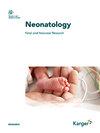Cerebellar Biometry in Preterm Infants.
IF 3
3区 医学
Q1 PEDIATRICS
引用次数: 0
Abstract
Dear Editor, I read with interest the article by Steiner et al. [1]. When comparing the z-score (ZS) for cerebellar measurements, we note that the interquartile range (IQR) has a positive ZS in the local controls for the height of the vermis and anteroposterior diameter (apVermis) measurements, while transverse cerebellar diameter (tCD) remained negative (−2.17 to −0.02). On correlation analysis, we note that for local controls, only apVermis ZS was significantly correlated with cognitive, language, and motor composite scales. On multivariable linear regression analysis, we see again that apVermis ZS was significant for the motor composite scale but not for the cognitive or language scale. These are significant findings. The cerebellum is chiefly associated with motor skills, visualmotor coordination, and balance; however, numerous developmental dyslexia theories have shown that decreased cerebellocortical connectivity and anomalies in the cerebellum structure contribute to language development [2]. Similarly, the cerebellum has been speculated to have a role in cognitive capabilities [2], but the international consensus from experts remains highly inferential [3]. In describing the possible reasons for reduced cerebellar sizes, Steiner et al. [1] stated that extremely premature (EP) infants have a vulnerable cerebellum, leading to cerebellar underdevelopment and rapid growth in late gestation, making the cerebellum particularly susceptible to poor growth. We would like to add another plausible reason for poor cerebral growth in EP infants. The cerebellum is supplied by the basilar artery, formed from the right and left vertebral arteries. The left vertebral artery arises from the left subclavian, which is post-ductal. EP infants invariably have patent ductus arteriosus (PDA), which could steal blood from reaching certain parts of the brain during diastole. This observation was shown recently by Lemmers et al. [4]. They studied a cohort of 90 preterm infants at <30 weeks of gestational age with PDA who underwent surgical ductal closure during 10 years and concluded that prolonged duration of a PDA was associated with reduced cerebellar growth and suboptimal neurodevelopmental outcome. This observation was also observed by Steiner et al. [1]. The intraventricular hemorrhage (IVH) group has more PDA ligation than the local controls, 10.8% versus 6.9%. In conclusion, considering Steiner et al. [1], more research is needed to investigate how cerebellar growth is compromised in EP infants with intraventricular hemorrhage and how it affects language and cognition.早产儿的小脑生物测量。
本文章由计算机程序翻译,如有差异,请以英文原文为准。
求助全文
约1分钟内获得全文
求助全文
来源期刊

Neonatology
医学-小儿科
CiteScore
0.60
自引率
4.00%
发文量
91
审稿时长
6-12 weeks
期刊介绍:
This highly respected and frequently cited journal is a prime source of information in the area of fetal and neonatal research. Original papers present research on all aspects of neonatology, fetal medicine and developmental biology. These papers encompass both basic science and clinical research including randomized trials, observational studies and epidemiology. Basic science research covers molecular biology, molecular genetics, physiology, biochemistry and pharmacology in fetal and neonatal life. In addition to the classic features the journal accepts papers for the sections Research Briefings and Sources of Neonatal Medicine (historical pieces). Papers reporting results of animal studies should be based upon hypotheses that relate to developmental processes or disorders in the human fetus or neonate.
 求助内容:
求助内容: 应助结果提醒方式:
应助结果提醒方式:


